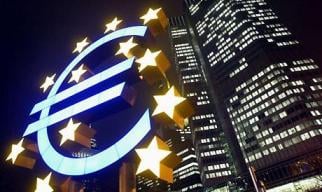European Central Bank Cuts Interest Rate Below Zero

The European Central Bank (ECB) slashed one of its interest rates to negative territory and unveiled a €400bn loan package for Europe’s banks in response to the ongoing economic slump and the threat of deflation.
At its meeting in Frankfurt Thursday, the central bank cut its main lending rate to 0.15 percent from its current historic low of 0.25 percent, and its overnight deposit rate from zero to minus 0.10 percent, becoming the largest central bank to lower rates to below zero.
The move is an expression of the fact that, nearly six years since the collapse of Lehman Brothers, the world economy remains mired in deep crisis, for which the world’s central banks have no solution outside of pumping trillions into banks and financial firms. While trillions are handed out to the banks, workers throughout the continent are told that there is “no money” to pay for pensions, social programs, and healthcare benefits.
At a press conference following the meeting, ECB President Mario Draghi made clear that the rate cuts could be followed in the near future by additional measures, including additional asset purchases similar to the Federal Reserve’s quantitative easing (QE) program.
“We think it is a significant package,” said Draghi. “Are we finished? The answer is no. If need be, within our mandate, we aren’t finished here,” adding that “a broad-based asset-purchase program is certainly one of” the instruments the Central bank has at its disposal.
On Tuesday, the ECB announced that inflation across the Eurozone fell to a rate of 0.5 percent in May, down from 0.7 percent in April, and far below its target of two percent. Inflation is expected to weaken further to 0.3 percent later this year, according to a forecast by Citibank.
The ECB also downgraded its estimate for Eurozone growth this year to 1 percent, down from its forecast of 1.2 percent in March.
Sensing the prospects of a fresh influx of funding, European stock markets reacted to the ECB decision with a rally. European stocks hit a six-and-a-half-year high, led by a surge in banking stocks, before falling back slightly. Noting that the German DAX hit an historic high on Thursday the Financial Times website ran the headline “DAX hits 10,000 as ECB package delights.”
In the United States, the S&P 500 closed up by 12 points, to 1,940, while the DOW Jones Industrial Average closed up by 98 points, at 16,836.11.
The ECB’s rate changes had been demanded for some time by the International Monetary Fund and the financial press. In its World Economic Outlook, issued at the beginning of April, the IMF drew attention to what a number of economists now refer to as the “new normal” for capitalism, i.e. stagnating or deflationary economies across the globe. The IMF report noted that real interest rates had been declining since the 1980s and were “now in slightly negative territory.”
At the same time, the report continued, the readiness of central banks to make massive amounts of cheap money available had failed to boost investment in productive industry. Instead the past period marked by the “scars” of the global financial crisis “have resulted in a sharp and persistent decline in investment in advanced economies.”
The report concluded that investment rates “in many advanced economies are unlikely to recover to pre-crisis levels in the next five years.”
The gloomy IMF forecast has been confirmed by recent figures from both the US and Europe. Economic activity across the Eurozone, as measured by the Purchasing Managers’ Index, fell to a six-month low in May. Meanwhile Europe’s jobless rate remains at an all-time high with unemployment expected to increase in the next months in some large economies such as Italy.
Following two years of Quantitative easing, during which time the US Federal Reserve pumped trillions of dollars into the markets, the United States economy remains mired in slump, and shrank at a one percent annualized rate in the first quarter of 2014. Retailers in the country missed their earnings estimates by the largest amount in thirteen years in the first quarter.
The ECB’s action is likely to only intensify currency tensions, as central banks pursue conflicting goals. The Federal Reserve is attempting to draw down its Quantitative easing program, while last month the Bank of England governor Mark Carney warned against the overheating of the British economy, and soaring house prices. Home prices in Britain rose by over 11 percent last year, the largest increase since June 2007. Carney is expected to shortly propose measures to restrict mortgage borrowing to rein in the new housing bubble.
As is the case with all the measures introduced by the world’s central banks since the crisis, the latest rate cuts by the ECB will do nothing to stimulate genuine economic growth. Instead, as was shown by the stock market rally Thursday, the ECB will only serve to fuel new speculative bubbles while further enriching the biggest banks and the millionaires and billionaires that control them.

